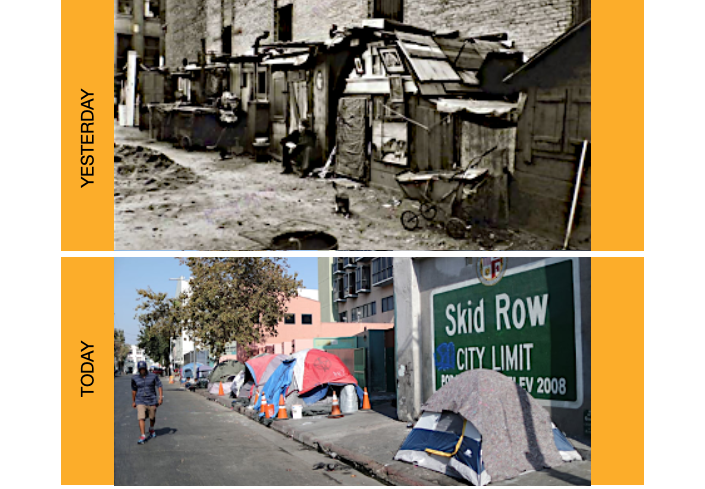CommentsPLANNING WATCH - From the Dog Bites Man Department: The recently adopted Los Angeles 2021-2029 Housing Element met its first legal challenge, with the likelihood of more to come.
According to the Los Angeles Times, the Aids Health Foundation (AHF) has sued the City of Los Angeles, arguing that the Housing Element’s up-zoning program does not include upgrades to infrastructure and public services sufficient to support the new buildings and their occupants.
If you have read the Housing Element and its environmental documents, this first lawsuit should not surprise you. Only City Hall hubris could have not seen it coming. If elected officials had carefully read the Housing Element’s Environmental Impact Report (EIR) chapter CEQA Findings of Fact and Statement of Overriding Considerations, they would know that LA’s new housing policies entirely depend on by-right (i.e., allowed) housing. If existing or new zoning permits a residential project, no upgrades to supportive infrastructure and services are therefore required. This is the City’s dubious legal rationale for its claim that LA’s old, failing infrastructure can handle the large amount of new residential construction that the Housing Element proposes. In cases where the EIR identifies categories where new residential development will overwhelm the LA’s existing infrastructure and public services, the City’s fallback position is that the extra cost and time to roll out these upgrades, such as air pollution control measures, makes them prohibitive.
“The City Council finds it is not feasible to apply Mitigation Measure 4.2-2(b) [SCAQMD air pollution measures] to ministerial housing projects for multiple policy reasons, including that it will add undesirable additional burdens, including cost, and additional time for project review, on housing projects which creates the risk of slowing down or reducing the construction and provision of desirable and urgently needed housing.”
While this legal loophole might prevail in courts that do not know that up-zoning produces expensive housing, it will not prevail over common sense, especially when it is clearly spelled out in the City’s adopted General Plan. For example, the General Plan’s Framework’s Policy 3.3.2.a requires prior municipal investment in infrastructure and public services before City Hall increases zoning to encourage additional real estate projects:
“Framework Policy 3.3.2.a: Determine the need and establish programs for infrastructure and public service investments to accommodate development in areas in which economic development is desired and for which growth is focused by the General Plan Framework Element.”
Since the adopted 2021-2029 Housing Element contains a 459 page appendix that identifies sites where existing zoning already allows additional housing, the claim that these parcels are, therefore, exempt from the General Plan’s requirement to upgrade infrastructure and public services in areas where new development is focused, is dubious.
Furthermore, the Housing Element’s Program 121 - RHNA Rezoning up-zones a minimum of 255,433 residential units. Their zoning will be increased through Community Plan Implementation Ordinances attached to new Community Plans, such as the 95 page up-zoning ordinance appended to the forthcoming Hollywood Community Plan Update.
This Housing Element’s implementation program also calls for citywide up-zoning that ushers in greater residential densities:
“Rezoned sites will permit owner occupied and rental multi-family uses by-right . . The Rezoning Program may also include more flexible zoning and incentives for existing single-family or lower density residential areas to create a variety of “missing middle” low scale housing typologies, include fourplexes, townhomes, rowhouses, additional affordable ADUs, bungalow courts, and other contextual typologies.”
The third form of up-zoning will, therefore, proceed through an expansion of the Transit Oriented Communities Guidelines, undoubtedly turned into ordinances via Community Plan Implementation Ordinances - to thwart new lawsuits:
“[The Housing Element] will create additional zoning capacity through an expansion of affordable housing incentive programs (Density Bonus Update) or other zoning code amendments.”
Since the large number of existing parcels, up-zoned parcels, and parcels eligible for density-bonuses only require ministerial approvals for new residential projects, they would not require improvements to local infrastructure and public services. While this provides a legal cover to avoid the infrastructure planning and upgrades required by the General Plan, it also creates a perfect storm for lawsuits, such as the AHF’s.
Behind the nuts and bolts of the lawsuit lies a bigger question. If the Housing Element survives this first legal challenge, will it actually work, or is it being sold to politicians and the public through a pile of phony claims? Will up-zoning produce its frequently promised low-income housing, or is the purpose of these baseless claims and outright lies to conceal the urban growth machine’s hidden agenda: increasing investors’ rate of profit through the construction of upscale housing in choice neighborhoods? If you critically examine the repeated claims cited to sell the new Housing Element, the answer is yes.
Once the Housing Element’s infrastructure claim is debunked, there is an even larger pile of lies and phony claims to camouflage an obvious reality. Its policies are already failing, and the desperate times of the Great Depression era are reappearing in Los Angeles. The Hoovervilles of 85 years ago are resurrecting, visible to all not taken in by the hype invoked to justify the new Housing Element’s giveaways to developers – at the expense of rent-gouged tenants.

Phony Claim #1. Existing infrastructure and public services can meet the needs of new buildings and their tenants.
As discussed above, this is the most obvious shortcoming of the new Housing Element since LA’s infrastructure and public services are already failing. If neighborhoods like Hollywood and Koreatown are burdened with more un-planned development through discretionary actions, the new Housing Element, and updated Community Plans, they will experience more electricity blackouts, burst water mains, backed-up sewers, traffic jams, and stalled emergency vehicles. This is why the General Plan Framework calls for infrastructure upgrades prior to up-zoning and new by-right construction.
Phony Claim #2. The up-zoners claim that through the “law” of supply-and-demand, building more expensive housing lowers the price of remaining older housing and, therefore, solves the homeless crisis.
There is no evidence that increasing the supply of expensive housing lowers housing costs, much less reduces homelessness. This is because this “law” only applies to situations where real estate investors make satisfactory profits, about 15-20 percent per year. If the profits are not there, unmet demand – in this case for low cost housing – never results in private investors building low-priced housing for low-income tenants. Furthermore, new market-rate housing not only displaces existing tenants, but it also pulls up the rents in older apartment buildings.
Phony Claim #3. In California the high cost of housing results from a housing shortage.
LA may have a shortage of lower-priced single family homes, but new McMansions, which cost $3 to 4 million, sit on the market for months, often resorting to short-term AirBnB rentals. As for apartments, what the up-zoners call missing middle housing, there is no shortage. For Rent signs are everywhere in LA as we enter the third year of recession and Pandemic. For example, a recent LA Department of Housing and Community Investment research paper estimated that Los Angeles had 85,000 – 100,000 empty housing units, or more than twice the number of homeless people. The highest vacancy rates were in new, expensive housing, exactly what results from up-zoning, because it is too expensive for most Angelinos.
Phony Claim #4. High density housing near transit increases transit ridership, and therefore reduces the Greenhouse Gas emissions responsible for climate change.
Up-zoning produces expensive market housing with high rents that only the well-off can afford. Since these tenants rely on cars, not buses and subways, for mobility, transit ridership continues to decline. For example, Hollywood and Downtown LA have plenty of new, high density transit-adjacent housing, but it has not reversed the long-term decline in transit ridership.
Phony Claim #5. The construction of higher density housing in high opportunity (i.e., affluent) neighborhoods reverses the racial legacy of red-lining.
This could happen if new housing was low priced and widely accessible to minority communities. But developers seldom build low-priced housing, and the City never inspects it to make sure landlords charge low rents in their pledged low-income units. As a result, new housing, including that resulting from up-zoning, reinforces existing racial patterns; it does not reverse them. Furthermore, up-zoning reduces the need for developers to apply for density bonuses to build higher density housing that includes a small percentage of low-income rental units.
Where there is smoke, there is fire. In this case the phony claims invoked to justify the new Housing Element’s up-zoning program reek of subterfuge. In their heart of hearts, the pols and planners either already know or will soon realize that their proposals make the housing crisis worse. Homelessness and homeless encampments will continue to grow, forcing the pols to turn even more to the LAPD to dislodge homeless encampments. As for the planners who brought us this debacle, they will try to emulate those colleagues who managed to fall upward when their plans failed.
(Dick Platkin is a former Los Angeles city planner who reports on local planning issues for CityWatchLA. He serves on the board of United Neighborhoods for Los Angeles (UN4LA) and co-chairs the Greater Fairfax Residents Association. Previous Planning Watch columns are available at the CityWatchLA archives. Please send questions and corrections to [email protected].)














